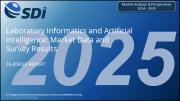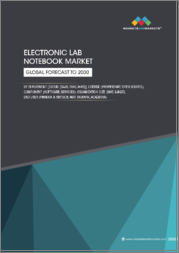
|
시장보고서
상품코드
1819854
세계의 실험실 정보학 시장 분석 : 제품별, 제공 방식별, 컴포넌트별, 최종 용도별, 지역별(2025-2033년)Laboratory Informatics Market Report by Product, Delivery Mode, Component, End Use, and Region 2025-2033 |
||||||
세계의 실험실 정보학 시장 규모는 2024년 38억 달러에 달했습니다. 향후 IMARC Group은 2033년까지 54억 달러에 이르고, 2025년부터 2033년까지 3.98%의 성장률(CAGR)을 보일 것으로 예측했습니다.
실험실 정보학은 장비, 소프트웨어 및 데이터 관리 도구를 이용한 정보 기술(IT)의 전문적 응용을 의미합니다. 과학적 데이터를 검색, 저장, 관리, 처리, 공유, 즉각적인 사용을 위한 해석을 가능하게 하는 중앙 시스템으로 사용합니다. 또한 연구실 업무의 효율을 극대화하고 고품질의 신뢰성 높은 데이터를 확보하면서 연구실에서의 시험 및 연구개발(R&D)을 지원합니다. 오늘날 실험실은 인간의 건강, 안전, 복지에 대한 우려가 높아짐에 따라 많은 국가의 정부가 정한 엄격한 정책과 규제 요건을 준수합니다. 그러므로 실험실 정보학에 대한 수요가 세계적으로 증가하고 있습니다.
실험실 정보학 시장 동향 :
급속한 세계화로 세계 기업들은 생산 효율성 향상과 신제품 시장 출시까지의 시간(TTM) 단축에 주력하고 있습니다. 결과적으로 데이터는 급격히 증가하고 시장 성장에 긍정적인 영향을 미칩니다. 실험실 정보는 데이터와 정보를 효과적으로 관리하고 기업이 지속적으로 변화하는 품질 관리 문제를 해결할 수 있도록 지원합니다. 이 외에도 만성 질환의 이환율이 증가하고 세계 의료 기록이 증가함에 따라 환자 치료의 전반적인 품질을 향상시키는 실험실 정보학에 대한 수요가 증가하고 있습니다. 게다가, 맞춤형 의료에 대한 선호도의 현저한 변화로 인해 건강 관리 관리에서 자동화의 채택이 증가하고 있다는 점도 시장 성장에 기여하고 있습니다. 또한, 코로나바이러스 감염(COVID-19)의 유행은 검사 순서, 등록, 샘플 흐름 및 결과 보고를 관리하기 위한 민첩한 실험실 정보학의 필요성을 상당히 증가시키고 있습니다. 게다가 주요 기업들은 맞춤형 솔루션을 제공하고 경쟁 우위를 확보하기 위해 기술적으로 첨단 플랫폼을 개발하여 시장을 견인할 것으로 예측됩니다.
이 보고서에서 답변을 얻을 수 있는 주요 질문
- 실험실 정보학 시장 규모는?
- 실험실 정보학 시장 전망은?
- 실험실 정보학 시장을 견인하는 주요 요인은?
- 세계의 실험실 정보학 시장에서 주요 기업은?
목차
제1장 서문
제2장 분석 범위 및 방법
- 분석 목적
- 이해관계자
- 데이터 소스
- 1차 정보
- 2차 정보
- 시장 추정
- 상향식 접근
- 하향식 접근
- 분석 방법
제3장 주요 요약
제4장 소개
제5장 세계의 실험실 인포매틱스 시장
- 시장 개요
- 시장 실적
- COVID-19의 영향
- 시장 예측
제6장 시장 분석 : 제품별
- 검사 정보 관리 시스템(LIMS)
- 전자연구노트(ELN)
- 과학 데이터 관리 시스템(SDMS)
- 실험실 실행 시스템(LES)
- 전자 데이터 수집(EDC), 임상 데이터 관리 시스템(CDMS)
- 크로마토그래피 데이터 시스템(CDS)
- 엔터프라이즈 컨텐츠 관리(ECM)
제7장 시장 분석 : 제공방식별
- On-Premise
- 웹 호스트
- 클라우드 기반
제8장 시장 분석 : 컴포넌트별
- 소프트웨어
- 서비스
제9장 시장 내역 : 최종 용도별
- 생명과학기업
- CRO
- 화학산업
- 식품 및 음료, 농업
- 환경시험연구소
- 석유화학정제소, 석유 및 가스산업
- 기타
제10장 시장 분석 : 지역별
- 북미
- 미국
- 캐나다
- 아시아태평양
- 중국
- 일본
- 인도
- 한국
- 호주
- 인도네시아
- 기타
- 유럽
- 독일
- 프랑스
- 영국
- 이탈리아
- 스페인
- 러시아
- 기타
- 라틴아메리카
- 브라질
- 멕시코
- 기타
- 중동 및 아프리카
제11장 SWOT 분석
제12장 밸류체인 분석
제13장 Porter's Five Forces 분석
제14장 가격 분석
제15장 경쟁 구도
- 시장 구조
- 주요 기업
- 주요 기업 프로파일
- Abbott Laboratories
- Agilent Technologies Inc.
- Dassault Systemes
- LabLynx Inc.
- LabVantage Solutions Inc
- LabWare
- PerkinElmer Inc.
- Thermo Fisher Scientific Inc.
- Waters Corporation
The global laboratory informatics market size reached USD 3.8 Billion in 2024. Looking forward, IMARC Group expects the market to reach USD 5.4 Billion by 2033, exhibiting a growth rate (CAGR) of 3.98% during 2025-2033.
Laboratory informatics refers to the specialized application of information technology (IT) using instruments, software, and data management tools. It functions as a central system that enables scientific data to be captured, stored, managed, processed, shared, and interpreted for immediate use. It also supports lab testing and research and development (R&D) while maximizing the efficiency of laboratory operations and ensuring high-quality and reliable data. Nowadays, laboratories are complying with stringent policies and regulatory requirements set by governments of numerous countries due to rising concerns over human health, safety, and welfare. This is catalyzing the demand for laboratory informatics worldwide.
Laboratory Informatics Market Trends:
Due to rapid globalization, organizations around the world are focusing on improving their production efficiency and reducing the time-to-market (TTM) of new products. This is resulting in the exponential growth of data, which, in turn, is influencing the market growth positively. Laboratory informatics assists in managing data and information effectively and allowing businesses to address their ever-changing quality management issues. Apart from this, the growing incidence of chronic diseases and rising medical records across the globe are also catalyzing the demand for laboratory informatics to enhance the overall quality of patient care. Additionally, the rising adoption of automation in healthcare management due to a significant shift of preferences towards personalized medicine is contributing to market growth. Moreover, due to the coronavirus disease (COVID-19) outbreak, there is a considerable rise in the need for agile laboratory informatics to manage test ordering, registration, sample flow, and result reporting. Furthermore, the leading companies are offering customized solutions and developing technologically advanced platforms to gain a competitive edge, which is anticipated to drive the market.
Key Market Segmentation:
Breakup by Product:
- Laboratory Information Management Systems (LIMS)
- Electronic Lab Notebooks (ELN)
- Scientific Data Management Systems (SDMS)
- Laboratory Execution Systems (LES)
- Electronic Data Capture (EDC) and Clinical Data Management Systems (CDMS)
- Chromatography Data Systems (CDS)
- Enterprise Content Management (ECM)
Breakup by Delivery Mode:
- On-premises
- Web-hosted
- Cloud-based
Breakup by Component:
- Software
- Services
Breakup by End Use:
- Life Science Companies
- CROs
- Chemical Industry
- Food & Beverage and Agriculture Industries
- Environmental Testing Laboratories
- Petrochemical Refineries and Oil & Gas Industry
- Others
Breakup by Region:
- North America
- United States
- Canada
- Asia-Pacific
- China
- Japan
- India
- South Korea
- Australia
- Indonesia
- Others
- Europe
- Germany
- France
- United Kingdom
- Italy
- Spain
- Russia
- Others
- Latin America
- Brazil
- Mexico
- Others
- Middle East and Africa
Competitive Landscape:
The competitive landscape of the industry has also been examined along with the profiles of the key players being Abbott Laboratories, Agilent Technologies Inc., Dassault Systemes, LabLynx Inc., LabVantage Solutions Inc, LabWare, PerkinElmer Inc., Thermo Fisher Scientific Inc. and Waters Corporation.
Key Questions Answered in This Report
- 1.How big is the laboratory informatics market?
- 2.What is the future outlook of laboratory informatics market?
- 3.What are the key factors driving the laboratory informatics market?
- 4.Which are the leading companies in the global laboratory informatics market?
Table of Contents
1 Preface
2 Scope and Methodology
- 2.1 Objectives of the Study
- 2.2 Stakeholders
- 2.3 Data Sources
- 2.3.1 Primary Sources
- 2.3.2 Secondary Sources
- 2.4 Market Estimation
- 2.4.1 Bottom-Up Approach
- 2.4.2 Top-Down Approach
- 2.5 Forecasting Methodology
3 Executive Summary
4 Introduction
- 4.1 Overview
- 4.2 Key Industry Trends
5 Global Laboratory Informatics Market
- 5.1 Market Overview
- 5.2 Market Performance
- 5.3 Impact of COVID-19
- 5.4 Market Forecast
6 Market Breakup by Product
- 6.1 Laboratory Information Management Systems (LIMS)
- 6.1.1 Market Trends
- 6.1.2 Market Forecast
- 6.2 Electronic Lab Notebooks (ELN)
- 6.2.1 Market Trends
- 6.2.2 Market Forecast
- 6.3 Scientific Data Management Systems (SDMS)
- 6.3.1 Market Trends
- 6.3.2 Market Forecast
- 6.4 Laboratory Execution Systems (LES)
- 6.4.1 Market Trends
- 6.4.2 Market Forecast
- 6.5 Electronic Data Capture (EDC) and Clinical Data Management Systems (CDMS)
- 6.5.1 Market Trends
- 6.5.2 Market Forecast
- 6.6 Chromatography Data Systems (CDS)
- 6.6.1 Market Trends
- 6.6.2 Market Forecast
- 6.7 Enterprise Content Management (ECM)
- 6.7.1 Market Trends
- 6.7.2 Market Forecast
7 Market Breakup by Delivery Mode
- 7.1 On-premises
- 7.1.1 Market Trends
- 7.1.2 Market Forecast
- 7.2 Web-hosted
- 7.2.1 Market Trends
- 7.2.2 Market Forecast
- 7.3 Cloud-based
- 7.3.1 Market Trends
- 7.3.2 Market Forecast
8 Market Breakup by Component
- 8.1 Software
- 8.1.1 Market Trends
- 8.1.2 Market Forecast
- 8.2 Services
- 8.2.1 Market Trends
- 8.2.2 Market Forecast
9 Market Breakup by End Use
- 9.1 Life Science Companies
- 9.1.1 Market Trends
- 9.1.2 Market Forecast
- 9.2 CROs
- 9.2.1 Market Trends
- 9.2.2 Market Forecast
- 9.3 Chemical Industry
- 9.3.1 Market Trends
- 9.3.2 Market Forecast
- 9.4 Food & Beverage and Agriculture Industries
- 9.4.1 Market Trends
- 9.4.2 Market Forecast
- 9.5 Environmental Testing Laboratories
- 9.5.1 Market Trends
- 9.5.2 Market Forecast
- 9.6 Petrochemical Refineries and Oil & Gas Industry
- 9.6.1 Market Trends
- 9.6.2 Market Forecast
- 9.7 Others
- 9.7.1 Market Trends
- 9.7.2 Market Forecast
10 Market Breakup by Region
- 10.1 North America
- 10.1.1 United States
- 10.1.1.1 Market Trends
- 10.1.1.2 Market Forecast
- 10.1.2 Canada
- 10.1.2.1 Market Trends
- 10.1.2.2 Market Forecast
- 10.1.1 United States
- 10.2 Asia-Pacific
- 10.2.1 China
- 10.2.1.1 Market Trends
- 10.2.1.2 Market Forecast
- 10.2.2 Japan
- 10.2.2.1 Market Trends
- 10.2.2.2 Market Forecast
- 10.2.3 India
- 10.2.3.1 Market Trends
- 10.2.3.2 Market Forecast
- 10.2.4 South Korea
- 10.2.4.1 Market Trends
- 10.2.4.2 Market Forecast
- 10.2.5 Australia
- 10.2.5.1 Market Trends
- 10.2.5.2 Market Forecast
- 10.2.6 Indonesia
- 10.2.6.1 Market Trends
- 10.2.6.2 Market Forecast
- 10.2.7 Others
- 10.2.7.1 Market Trends
- 10.2.7.2 Market Forecast
- 10.2.1 China
- 10.3 Europe
- 10.3.1 Germany
- 10.3.1.1 Market Trends
- 10.3.1.2 Market Forecast
- 10.3.2 France
- 10.3.2.1 Market Trends
- 10.3.2.2 Market Forecast
- 10.3.3 United Kingdom
- 10.3.3.1 Market Trends
- 10.3.3.2 Market Forecast
- 10.3.4 Italy
- 10.3.4.1 Market Trends
- 10.3.4.2 Market Forecast
- 10.3.5 Spain
- 10.3.5.1 Market Trends
- 10.3.5.2 Market Forecast
- 10.3.6 Russia
- 10.3.6.1 Market Trends
- 10.3.6.2 Market Forecast
- 10.3.7 Others
- 10.3.7.1 Market Trends
- 10.3.7.2 Market Forecast
- 10.3.1 Germany
- 10.4 Latin America
- 10.4.1 Brazil
- 10.4.1.1 Market Trends
- 10.4.1.2 Market Forecast
- 10.4.2 Mexico
- 10.4.2.1 Market Trends
- 10.4.2.2 Market Forecast
- 10.4.3 Others
- 10.4.3.1 Market Trends
- 10.4.3.2 Market Forecast
- 10.4.1 Brazil
- 10.5 Middle East and Africa
- 10.5.1 Market Trends
- 10.5.2 Market Breakup by Country
- 10.5.3 Market Forecast
11 SWOT Analysis
- 11.1 Overview
- 11.2 Strengths
- 11.3 Weaknesses
- 11.4 Opportunities
- 11.5 Threats
12 Value Chain Analysis
13 Porters Five Forces Analysis
- 13.1 Overview
- 13.2 Bargaining Power of Buyers
- 13.3 Bargaining Power of Suppliers
- 13.4 Degree of Competition
- 13.5 Threat of New Entrants
- 13.6 Threat of Substitutes
14 Price Analysis
15 Competitive Landscape
- 15.1 Market Structure
- 15.2 Key Players
- 15.3 Profiles of Key Players
- 15.3.1 Abbott Laboratories
- 15.3.1.1 Company Overview
- 15.3.1.2 Product Portfolio
- 15.3.1.3 Financials
- 15.3.1.4 SWOT Analysis
- 15.3.2 Agilent Technologies Inc.
- 15.3.2.1 Company Overview
- 15.3.2.2 Product Portfolio
- 15.3.2.3 Financials
- 15.3.2.4 SWOT Analysis
- 15.3.3 Dassault Systemes
- 15.3.3.1 Company Overview
- 15.3.3.2 Product Portfolio
- 15.3.3.3 Financials
- 15.3.3.4 SWOT Analysis
- 15.3.4 LabLynx Inc.
- 15.3.4.1 Company Overview
- 15.3.4.2 Product Portfolio
- 15.3.5 LabVantage Solutions Inc
- 15.3.5.1 Company Overview
- 15.3.5.2 Product Portfolio
- 15.3.6 LabWare
- 15.3.6.1 Company Overview
- 15.3.6.2 Product Portfolio
- 15.3.7 PerkinElmer Inc.
- 15.3.7.1 Company Overview
- 15.3.7.2 Product Portfolio
- 15.3.7.3 Financials
- 15.3.7.4 SWOT Analysis
- 15.3.8 Thermo Fisher Scientific Inc.
- 15.3.8.1 Company Overview
- 15.3.8.2 Product Portfolio
- 15.3.8.3 Financials
- 15.3.8.4 SWOT Analysis
- 15.3.9 Waters Corporation
- 15.3.9.1 Company Overview
- 15.3.9.2 Product Portfolio
- 15.3.9.3 Financials
- 15.3.9.4 SWOT Analysis
- 15.3.1 Abbott Laboratories



















